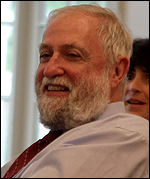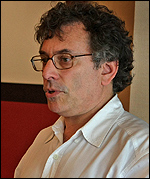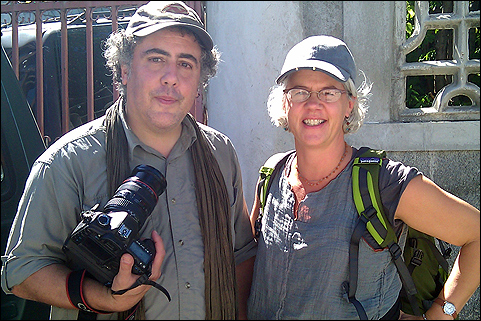The Dart-Nieman Collaboration
In early 2010, four years after its inception, the successful and ongoing collaboration between the Nieman Foundation and the
Dart Foundation underwent a strategic planning process to address new budget realities. Following a reassessment of all its grants, Dart generously decided to continue funding Nieman programs for at least three years, albeit at a lower annual commitment due to the fallout of the recent financial crisis.
As a result, the partnership has been transformed from a series of
Recent studies indicate that levels of PTSD and other forms of distress among journalists match those of soldiers, police, firefighters and other comparable front-line first responders.collaborative projects educating journalists about
trauma,
tragedy and
critical incidents into a more focused trauma journalism program. Building on the core strengths of the Nieman Foundation and our project collaborators — the
Dart Center for Journalism and Trauma at Columbia University and the
Dart Society — as well as our significant achievements together in previous years, we are launching two new projects while continuing our core support and training activities for fellows. The new undertakings will train journalists in countries in which a disproportionate number of traumatic events take place and teach reporters the special art of developing trauma narratives.
History and Motivation
The Dart-Nieman collaboration began its work in 2006 based on a simple yet critical premise: There is an intimate relationship between journalism and trauma, although one that is not well understood. Journalists work where emotional trauma occurs. They are witnesses and first responders to tragedy, violence, conflict and disaster.
The Nieman Foundation is profoundly familiar with this relationship. When the new fellows arrive at Lippmann House each fall, they are looking forward to a year living in safety; a year of intellectual and emotional exploration; a year to make time for their families. Few anticipate that taking a much needed break from journalism often comes with a catch: When they break free from stressors, fellows often begin to experience the impact their work has had not on their sources but on
them.
Typically, journalists have no training in the special challenges and responsibilities of reporting on traumatized individuals and communities, and little or no awareness of the significant emotional toll reporting on violence and tragedy can take on them. Recent studies indicate that levels of PTSD and other forms of distress among journalists match those of soldiers, police, firefighters and other comparable front-line first responders.
In providing journalists with a sabbatical, including new resources and insights on the topic of trauma in recent years, the Nieman Fellowship allows journalists who have been observers of violence and tragedy a restorative experience from the effects of compassion fatigue as well as the inspiration to continue in their work.
The Nieman Foundation is uniquely positioned to contribute to greater understanding of how trauma affects journalists and how trauma journalism affects the people and communities journalists cover. This is done in partnership with leading experts at the Dart Center who pioneered research in this area. Each year we work with a new class of Nieman Fellows as well as academics, researchers, artists and others involved in the exploration of trauma to evaluate its impact on people and their lives.
Through its global alumni base, the foundation also has a powerful way to begin sharing what is learned about trauma with journalists around the world.
Fellows’ Seminars and Support
Incoming Nieman classes now have access to trauma training because of our

Dr. Frank Ochberg

Bruce ShapiroDart collaboration. The fellows benefit from the extraordinary commitment of Dr. Frank Ochberg, a psychiatrist who specializes in violence and resilience and was a co-founder of the Dart Center for Journalism and Trauma, and Bruce Shapiro, an award-winning journalist and executive director of the center, and what both men continue to bring to this partnership.
The annual Dart journalism and trauma seminar — conducted exclusively for Nieman Fellows by Dr. Ochberg, Shapiro and Nieman collaboration manager Stefanie Friedhoff — has become an important source of initial information and a way to break the ice on this difficult subject. In 2010 we expanded the training, as requested by the class, by organizing an additional one-day workshop focusing on areas of specific concern to the fellows such as peer support and conducting trauma interviews.
Journalists vary in their needs and responses to traumatic events. Some of this diversity is cultural, some related to personalities and some based on experience. This is nowhere more obvious than in the Nieman seminar room, where a British or U.S. fellow’s “stiff-upper-lip” approach is often met with surprise from a Middle Eastern or South American fellow — and where two reporters from the same country and even the same news organization may differ greatly on how they want editors to approach them about their well-being.
Through the Dart-Nieman collaboration, we have developed a model to better approach these diverse needs, moving away from a traditional seminar format to initiating a conversation among Nieman Fellows in which they share stories, struggles, and coping strategies. What researchers have found out about trauma, how psychiatry treats individuals who develop pathologies or how journalists assist one another through peer support networks are topics not taught from a podium, but rather flow into the conversation as needed.
As part of the Dart-Nieman collaboration, fellows also have access to Dr. Ochberg and other local trauma experts on a one-on-one basis.
The Dart-Nieman Country Workshop Project
In 2010, the collaboration started a new initiative to bring trauma journalism resources to countries that have experienced repeated trauma and that have a strong Nieman alumni base interested in hosting such a training opportunity. In partnership with the Dart Center for Journalism and Trauma, which has experience providing trauma training in many nations, and the Dart Society, we hope to offer two such country-based workshops within the next three years. Countries of interest are, among others, Mexico, China and South Africa. The collaboration is currently seeking outside funding to support each individual country workshop. Those interested in supporting this important outreach program may contact
Stefanie_Friedhoff@harvard.edu for more information.
The Aftermath Journalism Project
Launched in the summer of 2010, the Aftermath Journalism Project builds on the success and promise of the 2009 Nieman conference “
Aftermath: Journalism, storytelling and the impact of violence and tragedy.” Attracting some 100 journalists, artists, trauma researchers, poets, novelists, historians and others, the event showcased the power of cross-disciplinary collaboration. It brought to light the overwhelming need to continue and foster a more systematic inquiry into how trauma narratives are formed, individually and collectively, in the aftermath of tragic events. It also explored how journalists report the emotional impact of violence, death and disaster on people’s lives.
While other Dart-Nieman programs focus on the emotional impact witnessing trauma can have on reporters, this project is concerned solely with storytelling. In close collaboration with the Dart Center for Journalism and Trauma, we will involve a diverse group of historians, artists, sociologists, neuroscientists, folklore experts and others in a dialogue with journalists. We will explore the many threads of trauma reporting, ranging from domestic violence to conflict reporting, by hosting individual panel discussions at both Harvard and Dart’s home base at Columbia University, working towards a better understanding of what it takes to produce informed, ethical and innovative news reporting on violence, conflict and tragedy.
Over time, we plan to share what we learn with journalists worldwide in various ways, including web publications and an anthology of essays written by leading trauma reporters discussing their craft.
- Stefanie Friedhoff
Special Projects Manager
Covering Cholera in Haiti: Two Fellowship Programs Collaborate on One Important Story
The Dart Center for Journalism and Trauma runs the Ochberg Fellowship program each fall, providing midcareer journalists an opportunity to deepen their knowledge of trauma and trauma reporting. Nieman Fellows Christina Lamb (class of 1994) and Hollman Morris (class of 2011) have been Ochberg Fellows, along with many other courageous journalists from the United States and abroad. By default, Ochberg Fellows become members of the Dart Society, an organization that supports journalists who cover violence and trauma through training, networking and project collaborations.
Bringing Nieman and Ochberg Fellows together to create a link between both programs and foster insightful, exemplary reporting on tragedy, conflict and disaster has been a goal for the Dart-Nieman Collaboration for years. In 2010, we were able connect Beth Macy, a 2010 Nieman Fellow and reporter at The Roanoke Times, with Ron Haviv, a 2004 Dart-Ochberg Fellow and photographer for the VII photo agency, to cover the medical response to the cholera epidemic in Haiti.

2010 Nieman Fellow Beth Macy (right) with photograher Ron Haviv in Haiti.
The reporting project was initiated and designed by Macy. Inspired by her Nieman year, she knew she wanted to profile Vanessa Carpenter, a local mother of 17 children (many of them adopted) and founder of Roanoke-based Angel Missions Haiti, a nonprofit providing medical services to those in need in Haiti. But Macy couldn’t find funding to support a trip to report the story from Port-au-Prince.
The Dart Society provided the grant and asked Ron Haviv, who has covered Haiti for more than a decade, to work with Macy. Deirdre Stoelzle-Graves, director of the Dart Society, and Nieman’s Stefanie Friedhoff worked closely with both journalists on the project.
The Roanoke Times, unable to send its reporters on international trips such as this one, embraced this new form of collaboration. The paper fully supported Macy and her work, from granting her the time to travel and write to assigning photo and text editors to the production to running her story on four and a half pages on a Sunday in December and posting multimedia elements on the paper’s website.
Macy unexpectedly was in lock-down for a day and a night as rioters in the north of the country, hardest struck by the cholera epidemic, unleashed their anger at the UN peacekeepers reportedly responsible for importing the deadly disease. She reported live from the scene, for PRI’s “The World,” speaking to her Nieman classmate Lisa Mullins. |